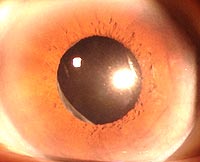Perform thorough exam, consider visual needs in cataract patient
 Uday Devgan |  Tina Geis | ||
With nearly 3 million cataract surgeries performed in the United States last year, it is no surprise that essentially every one of our patients will eventually undergo phacoemulsification and IOL implantation. As primary care eye doctors, it is our responsibility to be able to provide the best care and comanagement possible to ensure optimal outcomes for our patients. In the past decade, we have worked extensively in the pre- and postoperative care of thousands of ocular surgical patients and developed nomograms to simplify the process.
When a patient, an elderly one in particular, notices a difficulty in performing his or her normal life activities due to a significant decline in vision, we need to rule out the diagnosis of cataract. We are an integral part of the health care team to ensure that our patients’ vision is restored and that their ocular health is maintained.
Preop exam critical
Preoperative evaluation of the patient is critical and must be thorough. It includes both an ocular exam as well as a detailed discussion with the patient regarding his or her visual needs.
New IOLs can provide a wide range of good uncorrected vision and a degree of spectacle independence for most patients. While we all know about the multifocal IOLs (Advanced Medical Optics’ ReZoom and Alcon’s ReStor) because they have similarities with multifocal contact lenses, perhaps the most exciting development is the accommodating IOL (Bausch & Lomb’s Crystalens). Accommodating IOLs are the future of IOL technology; they aim to restore a full range of vision in a natural way while minimizing the glare, halos and dysphotopsias associated with multifocal IOLs.
The future of technology: the accommodating IOL
In our practice, the majority of patients receives bilateral implantation of the Eyeonics Crystalens and is spectacle-free for most of their daily activities. These patients are able to drive, watch television, cook, see their cell phones and read menus and normal print without glasses. Setting realistic expectations is important, such as “reading a newspaper with good lighting is reasonable, but expecting to read the words on the back of a packet of Splenda without glasses is pushing it.”
 |  |
| Before and after IOL implantation: The left photo shows a nuclear cataract. The right photo shows the same eye after implantation of an accommodating IOL. Images: Devgan U and Geis T | |
The current model of the Crystalens, the Five-O (named for the optic diameter of 5.0 mm) provides up to 2 D of accommodative amplitude. To further maximize the patient’s range of vision, we typically employ a “mini-monovision” technique, with the distance eye set for plano and the other eye set for about -1 D of residual myopia. This will provide an effective accommodative range of 3 D and clear vision from 33 cm to infinity.
The IOL dioptric power is based upon the patient’s keratometry and axial length, with a minimal reliance on the actual current refraction. Because cataracts – nuclear cataracts in particular – can cause refractive shifts, you may find that your manifest refraction seems unstable. We use an optical means of measuring the axial length, the Zeiss IOL Master (Carl Zeiss Meditec, Dublin, Calif.) or an ultrasound A-scan. The IOL Master is many times as accurate as the ultrasound, so it has become the tool of choice.
For the typical patient, our emphasis is on providing accurate keratometry, a complete eye exam and documentation of a decline in the patient’s vision and difficulties in daily activities. The following case example represents many of our patients.
Case study: nuclear cataracts
A 58-year-old man has a history of declining vision and difficulty driving at night due to the glare from lights. His best-corrected visual acuity is 20/50 OD with +2.25 D -1.50 D x 180 and 20/40 OS with +2.50 D -1.50 D x 180. With glare testing, his BCVA is 20/100 OD and 20/80 OS. Keratometry is 45.25 x 90/43.75 x 180 OD and 44.75 x 90/43.25 x 180 OS. The slit lamp exam revealed 3+ nuclear sclerosis OD and 2+ nuclear sclerosis OS. The dilated fundus exam was normal, and he had a 0.3 cup:disc ratio OD and 0.3 cup:disc ratio OS.
The patient works as a computer analyst, is an avid bicyclist and desires freedom from glasses for as many activities as possible.
This is an ideal patient for cataract surgery with implantation of an accommodating IOL because it will restore a full range of vision to him while minimizing any dysphotopsias or glare/halos. Care was taken to explain to the patient that he may need spectacles for prolonged reading of fine print or prolonged night driving.
Our practice emphasizes teamwork, and primary eye care doctors are welcome to accompany the patient on the day of surgery to observe first-hand the technique of surgery. In this patient’s situation, the surgeon was able to correct the hyperopia and presbyopia with the accommodating IOL and address the astigmatism with limbal relaxing incisions (the topic of a future column).
For more information:
- Uday Devgan, MD, FACS is in private practice in Los Angeles, chief of ophthalmology at Olive View-UCLA Medical Center and an associate clinical professor at the Jules Stein Eye Institute at the UCLA School of Medicine.
- Tina Geis, OD, specializes in the preoperative evaluation and postoperative care of patients at Maloney Vision Institute.
- Both doctors can be reached at Maloney Vision Institute, 19021 Wilshire Blvd. #900, Los Angeles, CA 90024; (310) 208-3937; fax: (310) 208-0169; www.maloneyvision.com; e-mail: drdevgan@maloneyvision.com and drgeis@maloneyvision.com.
